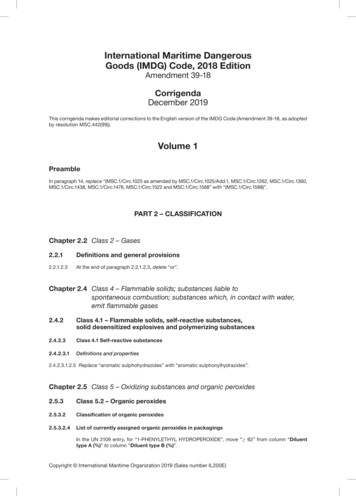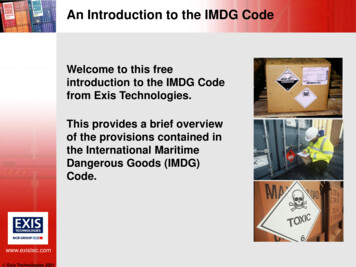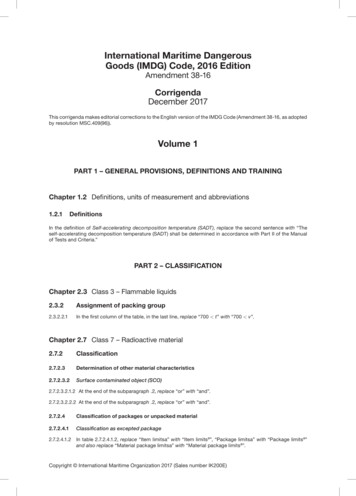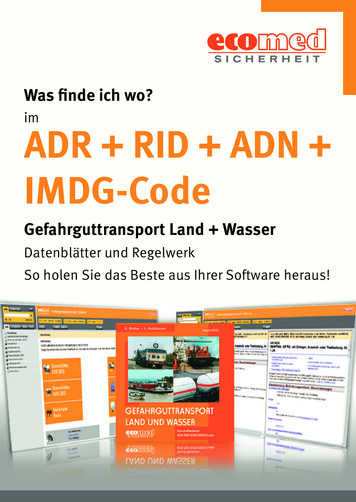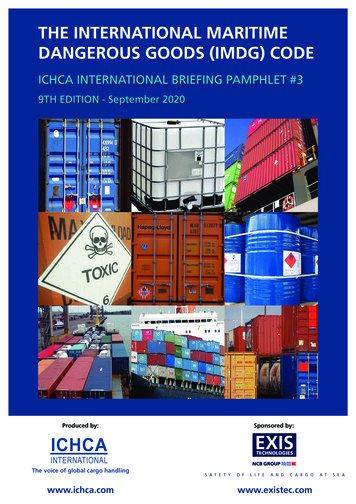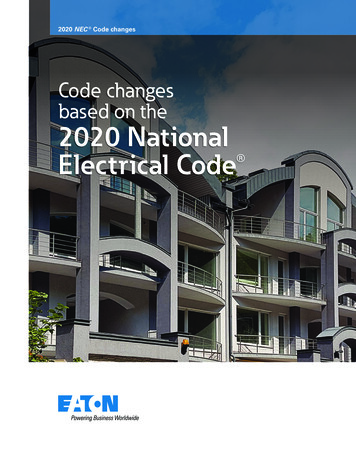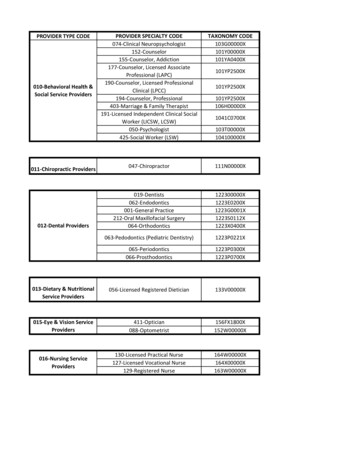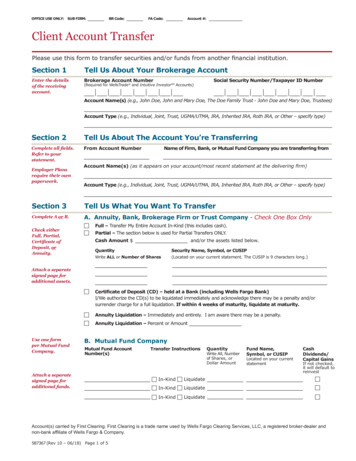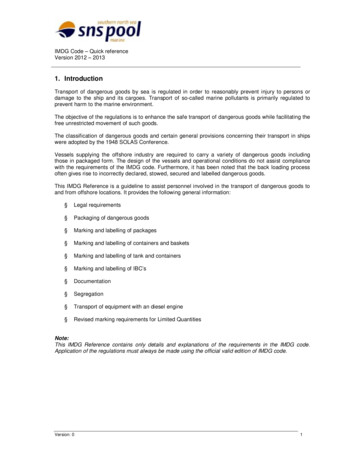
Transcription
IMDG Code – Quick referenceVersion 2012 – 20131. IntroductionTransport of dangerous goods by sea is regulated in order to reasonably prevent injury to persons ordamage to the ship and its cargoes. Transport of so-called marine pollutants is primarily regulated toprevent harm to the marine environment.The objective of the regulations is to enhance the safe transport of dangerous goods while facilitating thefree unrestricted movement of such goods.The classification of dangerous goods and certain general provisions concerning their transport in shipswere adopted by the 1948 SOLAS Conference.Vessels supplying the offshore industry are required to carry a variety of dangerous goods includingthose in packaged form. The design of the vessels and operational conditions do not assist compliancewith the requirements of the IMDG code. Furthermore, it has been noted that the back loading processoften gives rise to incorrectly declared, stowed, secured and labelled dangerous goods.This IMDG Reference is a guideline to assist personnel involved in the transport of dangerous goods toand from offshore locations. It provides the following general information:§Legal requirements§Packaging of dangerous goods§Marking and labelling of packages§Marking and labelling of containers and baskets§Marking and labelling of tank and containers§Marking and labelling of IBC’s§Documentation§Segregation§Transport of equipment with an diesel engine§Revised marking requirements for Limited QuantitiesNote:This IMDG Reference contains only details and explanations of the requirements in the IMDG code.Application of the regulations must always be made using the official valid edition of IMDG code.Version: 01
IMDG Code – Quick referenceVersion 2012 – 20132. Legal requirementsThe regulations for the transport of dangerous goods by sea in The Netherlands are shown in theschedule below.Wet Vervoer Gevaarlijke Stoffen (WVGS)(Law on the Transport of Dangerous Goods)Reglement Vervoer Gevaarlijke Stoffen (RVGS)(Regulations on the Transport of Dangerous Goods)Regeling Vervoer Gevaarlijke Stoffen over deBinnenwateren (VBG)(Regulations governing the Transport of DangerousGoods on Inland Waterways)Regeling Vervoer Gevaarlijke Stoffen met Zeeschepen(RVGZ)(Regulations governing the Transport of DangerousGoods with seagoing Vessels)International Maritime Dangerous Goods Code(IMDG code)As shown in this schedule, transport by sea-going vessels must be in compliance with the general rulesof the Dangerous Goods Act (WVGS), the Dangerous Goods Regulations (BVGS), the Regulationsgoverning the transport on inland waterways (VBG), the Regulations governing the transport ofdangerous goods with sea-going vessels (RVGZ) and the International Maritime Dangerous Goods Code(IMDG code).Version: 02
IMDG Code – Quick referenceVersion 2012 – 20133. Packaging of dangerous goodsUN approved packingIn general, dangerous goods must be packed in (UN) approved packages.Packages such as boxes, drums, jerry cans, cylinders and intermediate bulk containers (IBCs) must beUN certified. For gas cylinders, which are not UN certified, national approval is also acceptable.Tank containers must be either of an IMO or UN type and must have a valid certification on their test dataplate.Limited QuantitiesDangerous Goods in limited quantities may be carried in non UN approved packages, provided themaximum quantity per inner package does not exceed the specified limits and the inner packages arefirmly secured in outer packagings.The gross mass of the completed package must not exceed 30 kg.OverpacksIf dangerous goods packages are shrink-wrapped on a pallet or contained within e.g. a box pallet, thepallet should be treated as an overpack.Version: 03
IMDG Code – Quick referenceVersion 2012 – 20134. Marking and labelling of packagingsEvery package containing dangerous goods must be marked with the UN number (preceded by theletters UN) and the proper shipping name, e.g. UN 1230 METHANOL.Packagings containing dangerous goods in Limited Quantities need not to be marked with the propershipping name, but must be marked with the limited quantity mark.Marking and labellingUN approved drumMarking of a packagingwith Limited QuantityNote: For limited quantity packages that also comply with the regulations for air transport, the limitedquantity placard may contain the letter “Y” in the middle part.Marking and labelling of overpacksOverpacks must be marked with the UN number(s) and proper shipping name(s) of all substancescontained within the overpack and the word OVERPACK.Overpacks must be marked with hazard labels of 10 x 10 cm for each dangerous goods contained withinthe overpack.Overpacks containing only dangerous goods in Limited Quantities must be marked with the LimitedQuantity placard and the word OVERPACK.Version: 04
IMDG Code – Quick referenceVersion 2012 – 20135. Marking and placarding of cargo transport units(containers, baskets)GeneralRecently we have noticed some confusion with regards to the placarding of cargo transport unitscontaining dangerous goods. A cargo transport unit - freight container, basket or tank container containing dangerous goods or residues of dangerous goods shall clearly display placards on each sideand on each end of the unit indicating the risk of the content. Tank containers must also be marked withthe UN number on each side and the proper shipping name on 2 opposite sides.Hazard labelsContainers or baskets that are loaded with dangerous goods in packages with hazard labels must beplacarded on four sides with the same hazard labels as shown on the packages. The placards must havedimensions of not less than 25 x 25 cm.Basket loaded with dangerous goods - Placards on 4 SIDESExceptionsPlacards are NOT required on cargo transport units- Carrying any quantity of explosives of division 1.4 compatibility group S- Carrying excepted packages of radioactive material – class 7UN2908 RADIOACTIVE MATERIAL, EXCEPTED PACKAGE, EMPTY PACKAGEUN 2910 RADIOACTIVE MATERIAL, EXCEPTED PACKAGE, LIMITED QUANTITY OF MATERIALUN 2911 RADIOACTIVE MATERIAL, EXCEPTED PACKAGE, ARTICLES- Carrying dangerous goods packed in Limited QuantitiesContainers and baskets that only contain dangerous goods in Limited Quantities must on four sides beplacarded with the Limited Quantity mark, which must have dimensions of 25 x 25 cm.Container with ONLY dangerous goods in Limited Quantities - Limited Quantity placard on 4 SIDESVersion: 05
IMDG Code – Quick referenceVersion 2012 – 2013Packages with hazard labels and Limited Quantities in the same cargo transport unitWhen both packages with hazard labels and packages containing dangerous goods in Limited Quantitiesare loaded together in the same container, the container should only be placarded with the applicablehazard labels, not with the Limited Quantity mark.6. Marking and placarding of tank containersTank containers must be placarded with hazard labels (25 x 25 cm) showing the UN number on a whitebackground in the lower half of the label on four sides and must show the proper shipping name of thecontents on two opposite sides (those with the forklift pockets).orbe labelled with hazard labels (25 x 25 cm) and orange placard with the UN number on four sides andmust show the proper shipping name of the contents on two opposite (long) sidesOption 1Note: hazard labels and UN number to be affixed on four sides,proper shipping name on two opposite sidesOption 2Note: hazard labels and orange signs to be affixed on four sides,proper shipping name on the two opposite sidesMinimum dimensions of the UN number and the proper shipping nameThe UN number and proper shipping name shall be displayed in characters not less than 65 mm high andshall be of the contrasting colour with the background.Version: 06
IMDG Code – Quick referenceVersion 2012 – 20137. Intermediate Bulk Container – IBCAlso IBC’s sometimes cause confusion.The unit below should be considered an IBC with a content of more than 450 L.The requirements for the marking and labelling of IBC’s 450 L are: Dangerous goods placards 10 x 10 cm. on 2 opposite sides Proper shipping name on 2 opposing sides UN number on 2 opposing sidesHazard labels (10x10 cm)UN NUMBERPROPER SHIPPING NAMEIt is also possible to use 25 x 25 cm on 4 sides as long as the UN number and the proper shipping nameare also displayed on 2 opposite sides.Version: 07
IMDG Code – Quick referenceVersion 2012 – 20138. Overview marking and labellingThe table below provides an overview of the requirements for marking and labelling.TypeMarkingHazard labels / Placards(inclusive Marine Pollutantmark)Packages UN number and Proper shipping nameLabels (10 x 10 cm) on one sideOverpacksRadioactivepackagesIBCs ( 450 L) ContainersTank containersVersion: 0 UN number and Proper shipping nameThe word “OVERPACK”UN number and Proper shipping nameAdditional markings (see IMDG-code5.2.1.5)UN number and Proper shipping nameon two opposite sidesUN number if more than 4000 kg of thesame substance; otherwise no markingsrequired;The Limited Quantity mark if onlydangerous goods in limited quantities areloaded in the containerUN number on four sidesProper shipping name on two oppositesidesLabels (10 x 10 cm) on one sideLabels (10 x 10 cm) on twoopposite sidesLabels (10 x 10 cm) on twoopposite sidesPlacards (25 x 25 cm) on foursidesPlacards (25 x 25 cm) on foursides8
IMDG Code – Quick referenceVersion 2012 – 20139. Applicable labels for Dangerous GoodsClass 1.1, 1.2, 1.3 *ExplosivesClass 1.4 **ExplosivesClass 2.1Flammable gasClass 2.2 Non-flammable,non-toxic gasClass 2.3Toxic gasClass 3Flammable liquidClass 4.1Flammable solidClass 4.2SpontaneouslycombustibleClass 4.3Dangerous when wetClass 5.1Oxidizing substanceClass 5.2Organic peroxideClass 6.1Toxic substancesClass 6.2Infectious substancesClass 7Radioactive - I-WhiteClass 7Radioactive - II-YellowClass 7Radioactive - III-YellowClass 8CorrosivesClass 9MiscellaneousMarine PollutantLimited quantity* Class number and compatibility group to be shown in lower half of the label, e.g. 1.3G** Letter of the compatibility group to be shown in lower half of the label, e.g. GVersion: 09
IMDG Code – Quick referenceVersion 2012 – 201310. Documentation for Dangerous GoodsGeneralWhen dangerous goods are offered for transport a document is required to give carrier informationapplicable to the dangerous goods.The format of the document is free but it must contain all required information as per the IMDG code.Information required1. UN number preceded by the letters “UN”2. Proper shipping name3. Primary hazard class or division and for class 1 the compatibility group letter4. Subsidiary hazard class where applicable5. Packing group where applicableThese 5 elements of the DG description must be shown in the order listed above with no informationinterspersed, except as provided in the IMDG code. Unless permitted or required by the IMDG codeadditional information shall be placed after the DG description.Additional informationIn addition the following information regarding the dangerous goods shall be included:- Total quantity – in case of class 1(explosives) the total net quantity of explosives- Number and kind of package- Indication of Marine Pollutant where applicable- Flashpoint if 60 C or less- In case of limited quantity the words “limited quantity” or “LTD QTY” shall be includedSupplements to the Proper shipping nameThe proper shipping name in the dangerous goods description shall be supplemented as follows:- If special provision 274 is mentioned in column 6 of the Dangerous Goods List the propershipping name shall be supplemented with the technical or chemical group name.- Empty means of containment (including packagings, IBCs, bulk containers, portable tanks, roadtank vehicles and railway tank wagons) which contain the residue of dangerous goods of classesother than Class 7 shall be described as such by, for example, placing the words "EMPTYUNCLEANED" or "RESIDUE LAST CONTAINED" before or after the proper shipping name.- For waste dangerous goods (other than radioactive wastes) which are being transported fordisposal, or for processing for disposal, the Proper Shipping Name shall be preceded by the word"WASTE", unless this is already a part of the proper shipping name.Container / vehicle packing certificateWhen Dangerous Goods are packed or loaded in a container the person of the organization responsiblefor the packing/loading of the container or vehicle shall provide a “container/vehicle packing certificate”.This certificate may be part of the IMO Dangerous Goods Declaration or the Multimodal DangerousGoods Declaration form.Note 1: The container/vehicle packing certificate is NOT required for tank containersNote 2: If the Dangerous Goods Declaration is only submitted to the carrier in an electronic format, thesignature(s) may be replaced by the name (in capitals) of the person(s) authorized to sign.Version: 010
IMDG Code – Quick referenceVersion 2012 – 2013Example of an IMO Dangerous Goods DeclarationMULTIMODAL DANGEROUS GOODS FORM1 Shipper/Consignor/Sender2 Transport document numberOil Field ServicesK16B PlatformContinental ShelfThe Netherlands3 Page 1 of 1 pagesQRG-124 Shipper's reference5 Freight forwarder's reference6 Consignee7 Carrier (to be completed by the carrier)Peterson SBS Den Helder BVPaleiskade 431781 AN Den HelderSNS Pool8 This shipment is whitin the limitations prescribed for:(Delete non-applicable)SHIPPER'S DECLARATIONI hereby declare that the contens of this consignment are fully and accurately describedbelow by the Proper Shipping Name, and are classified, packaged, marked and labelled/placarded and are in all respects in proper condition for transport according to the applicableinternational and national governmental regulations.PASSENGER AND CARGO AIRCRAFTCARGO AIRCRAFT ONLY10 Vessel/flight No and date11 Port/place of loading9 Additional handling informationPOOL VESSELK16B24 hour emergency response
IMDG Code – Quick reference Version 2012 – 2013 Version: 0 1 1. Introduction Transport of dangerous goods by sea is regulated in order to reasonably prevent injury to persons or damage to the ship and its cargoes. Transport of so-called marine pollutants is primarily regulated to prevent harm to the marine environment. The objective of the regulations is to enhance the safe transport of .
